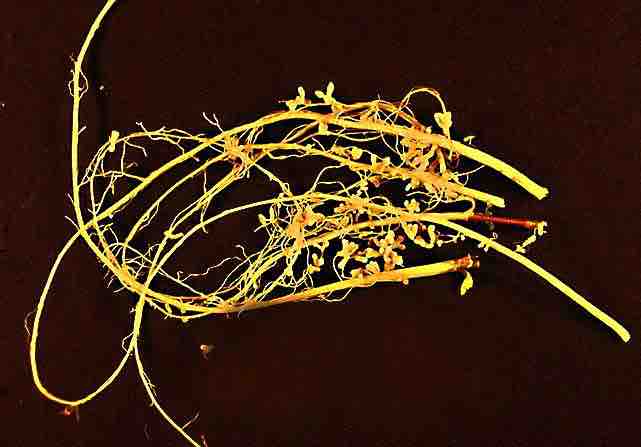An endophyte is an endosymbiont, often a bacterium or fungus, that lives within a plant for at least part of its life without causing apparent disease . Endophytes are ubiquitous and have been found in all the species of plants studied to date. However, most of these endophyte/plant relationships are not well understood. Many economically important forage and turfgrasses (e.g., Festuca spp., Lolium spp.) carry fungal endophytes (Neotyphodium spp.) which may improve the ability of these grasses to tolerate abiotic stresses such as drought, as well as improve their resistance to insect and mammalian herbivores.

Root nodules on a legume
Soybean root nodules, each containing billions of Bradyrhizobium bacteria.
Endophytes may be transmitted either vertically (directly from parent to offspring) or horizontally (from individual to unrelated individual). Vertically transmitted fungal endophytes are asexual and transmit via fungal hyphae penetrating the host's seeds (e.g., Neotyphodium). Since their reproductive fitness is intimately tied to that of their host plant, these fungi are often mutualistic. Conversely, horizontally transmitted fungal endophytes are sexual and transmit via spores that can be spread by wind and/or insect vectors. Since they spread in a similar way to pathogens, horizontally transmitted endophytes are often closely related to pathogenic fungi, although they are not pathogenic themselves.
Endophytes may benefit host plants by preventing pathogenic organisms from colonizing them. Extensive colonization of the plant tissue by endophytes creates a "barrier effect," where the local endophytes outcompete and prevent pathogenic organisms from taking hold. Endophytes may also produce chemicals which inhibit the growth of competitors, including pathogenic organisms. Some bacterial endophytes have proven to increase plant growth. The presence of fungal endophytes can cause higher rates of water loss in leaves. However, certain fungal endophytes help plants survive drought and heat. Plant use of endophytic fungi in defense is a very common phenomenon, primarily involving the arbuscular mycorrhizal fungi.
The wide range of compounds produced by endophytes have been shown to combat pathogens and even cancers in animals including humans. One notable endophyte with medicinal benefits to humans was discovered by Gary Strobel: Pestalotiopsis microspora, an endophytic fungus of Taxus wallachiana (Himalayan Yew) was found to produce taxol. Endophytes are also being investigated for roles in agriculture and biofuels production. Inoculating crop plants with certain endophytes may provide increased disease or parasite resistance while others may possess metabolic processes that convert cellulose and other carbon sources into "myco-diesel" hydrocarbons and hydrocarbon derivatives. Piriformospora indica is an interesting endophytic fungus of the order Sebacinales, the fungus is capable of colonizing roots and forming symbiotic relationship with every possible plant on earth. P. indica has also been shown to increase both crop yield and plant defence of a variety of crops (barley, tomato, maize, etc. ) against root-pathogens.
It is speculated that there may be many thousands of endophytes useful to mankind. However, since there are few scientists working in this field, and since forests and areas of biodiversity are rapidly being destroyed, many useful endophytes for curing disease might be permanently lost for medicinal use before they are discovered. The effects of climate change on endophytes are being investigated. Studies of plants grown at different climates or at increased carbon dioxide levels have different distributions of endophytic species.